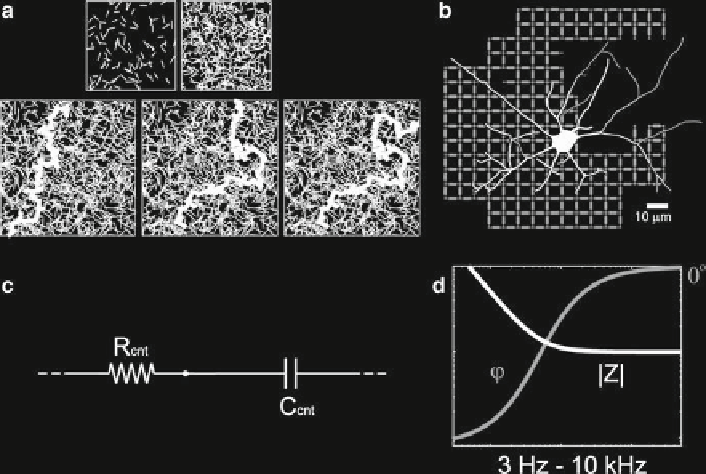Biomedical Engineering Reference
In-Depth Information
Fig. 4
Model of CNTs as a cell-growth substrate. Random dispersions of computer-generated
small segments on a fi nite area (
a
) mimic CNT surface coating for cell growth. For increasing
dispersion density, a dense meshwork of elements appears, and the network percolation limit for
electrical conductivity is readily overcome. Thus, between two points of the (simulated) substrate,
there exist a
chain
of conductive elements, forming a resistive electrical path (outlined in
dark
).
Individual neurons cultured over CNT layers are thought coupling to a heterogeneous 2-dimensional
resistive network, sketched in (
b
) as a resistive grid. Electrochemical properties of the interface
between the CNT substrate and the electrolyte are instead mostly capacitive and described by a
standard electrochemical impedance model (
c
);
R
cnt
, CNT equivalent resistance;
C
cnt
, CNT equiva-
lent capacitance. This description is equivalent to a linear impedance Z, whose magnitude |
Z
| and
phase
j
have been sketched qualitatively in the frequency domain (
d
)
nanotubes with semiconducting and metallic properties is usually obtained, as visualized
by electron microscopy in Fig.
3a
(Radosavljevic et al.
2001
; Georgakilas et al.
2002
; Snow et al.
2003
). Because of the high surface density, a large amount of
tubes with metallic properties are randomly dispersed and oriented among the oth-
ers. Therefore, a
percolating
network of electrical pathways between any two points
of the mesh is likely to emerge (Snow et al.
2003
). Then, even with relatively small
probability of contacts between two neighboring tubes with metallic properties,
long-range electrical conduction can be achieved through intermediate steps between
any two points of the mesh (Kirckpatrick
1972
). This has been graphically illus-
trated in Fig.
4a
, where a simple geometrical computer model of randomly dis-
persed segments was simulated and analyzed. As in a
random graph
(Bollobás
2001
) , two neighboring
nodes
are connected if the corresponding “black needles”
intersect each other. Then, for suffi ciently large network sizes, a path between any
two points almost certainly exists in the simulated nanotube dispersion (Fig.
4a
).

